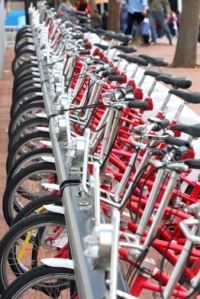 On Sunday 25 March, we discussed the paper on health benefits and risks of cycling vs car use in urban areas (Health Impact Assessment study). Full citation:
On Sunday 25 March, we discussed the paper on health benefits and risks of cycling vs car use in urban areas (Health Impact Assessment study). Full citation:
D. Rojas-Rueda, A. de Nazelle, M. Tainio, M. J. Nieuwenhuijsen (2011) The health risks and benefits of cycling in urban environments compared with car use: health impact assessment study BMJ 343 (aug04 2) p. d4521-d4521 http://www.bmj.com/cgi/content/abstract/343/aug04_2/d4521
See the previous post for our pre-club summary & questions.
A full transcript of the discussion can be reviewed here (see our Archive page, above, for pdf version).
There was a query about whether the paper really reported on a Health Impact Assessment as it is usually understood within public health /policy planning practice:
https://twitter.com/#!/304491701/status/183992625165119488
The narrowness of the focus was also discussed – while appropriate as a research question, HIAs would usually be broad in scope, at least initially. However, the study could be regarded as an exercise in applied methods.
1. Aims of the study: the paper made these quite clear. We did query the claim to assess ‘cycling’ impact while focusing on a Public Bike Sharing Scheme (PBSS, specifically Barcelona’s ‘Bicing’ scheme). We conjectured that if (as the paper suggests) many PBSS users are new to using cycling for urban journeys, experiences/ health impacts are different than for more ‘serious’ or regular cyclists.
2. Were the parameters used to model health impacts clear, relevant and valid?
The finding that the benefits of a switch to cycling outweighed any increased risk from traffic fatalities and exposure to pollution was welcomed as important. However, the claim to study health impacts was felt to be limited due to a lack of a definition of ‘health’ and its parameters. Also, the focus on mortality, although making use of easily available data, meant that wider risks and benefits to cyclists, such as non-fatal injuries and improved overall fitness, may have been missed.
The study assessed the impact on the wider population by calculating changes in CO2 emissions. We discussed potential further benefits to populations of a switch towards cycling and other active transport modes. Discussants pointed to existing research on the impact of urban design and traffic volume on well-being (see below).
3. Are the findings justifiable?
It was accepted that an increase in numbers cycling and positive environmental impacts were demonstrated by the study.
The main issue that participants had with the findings is one that has been already widely discussed in the Rapid Responses to the article: the assumption that 90% of Bicing scheme users had swapped from cars. The authors’ own data (indicated in their sensitivity analysis) pointed to only 10% of Bicing users having switched from cars. One participant compared the data on modal shift to that from London’s PBSS (‘Boris bikes’)- where only a tiny fraction of journeys would otherwise have been made by car (link below).
4. Could anything else explain the findings?
There was a wider discussion of the aims of PBSS and their scope to encourage a switch to active forms of transport:
Note also that more than half the population own a bicycle: lack of bikes isn’t the main barrier to journeys being made by them. #PHTwitJC
— Joe Dunckley (@steinsky) March 25, 2012
The ‘safety in numbers’ and ‘critical mass’ arguments for generating a switch to cycling and reducing its risks were also covered. That is, is there evidence that a PBSS could ‘normalise’ and encourage cycling more widely; do increased numbers of cyclists increase driver awareness and therefore safety? Discussants familiar with research on this area felt that the evidence is not very convincing (some examples below).
5. What are the implications for policy and practice?
Without comparators, it is difficult to make wider conclusions on the study findings. Impacts of PBSS uptake /an increase in cycling are likely to be context dependent: street design, road infrastructure, culture of car use and related transport policies vary between cities.
The relationship between other active forms of transport (e.g. walking) and cycling was not very clear in the study, and there was a suggestion that policies promoting cycling might be the ‘wrong bandwagon’ in terms of improving urban health. Overall, the findings were felt to be fairly limited:
Shows more people cycling has clear health benefits, but less clear as to whether Bicing is way to do this? #PHTwitJC
— Duck (@brainduck) March 25, 2012
Discussants suggested the following links for further reading / related research:
Discussion dismissing “safety in numbers” hypothesis on cycling uptake -blog post by Vole O’Speed – http://t.co/w0vhJ1Hm via @steinsky
‘Driven to Excess’ – http://t.co/ttQAL8tl – Living Streets UK report on study of wider health & social impacts of heavy traffic by Joshua Hart (2008) – via @fibigibi13
Donald Appleyard – info on urban design researcher & campaigner for ‘livable streets’ « Project for Public Spaces – Placemaking for Communities – http://t.co/Xq5JSwRn via @fibigibi13
WHO Health Impact Assessment Glossary http://t.co/TOxyyQDD -mentions ‘retrospective’ HIA – via @fibigibi13
Modal Shift (Or Otherwise) in London’s cycle hire scheme – discussion by BorisWatch http://t.co/SGi7xeLA (via @steinsky )
Cycling Embassy of Great Britain – discussion of ‘Barriers to Cycling’ http://t.co/OBO6Dwqb (from @steinsky )
